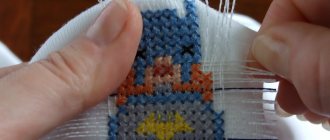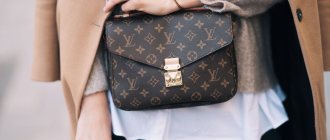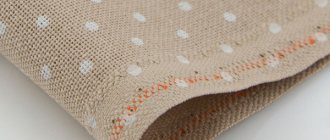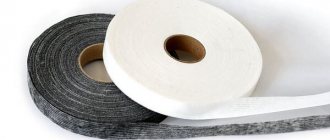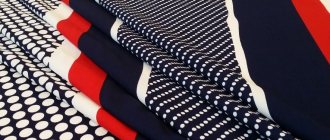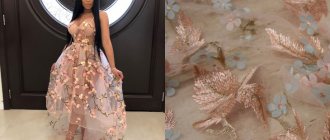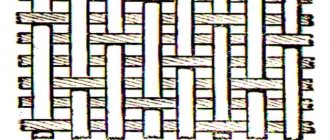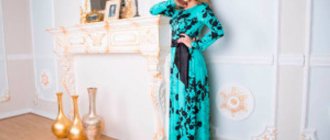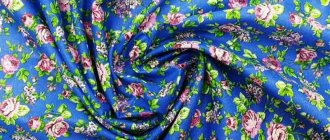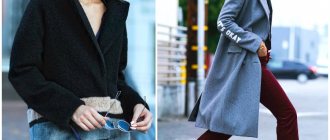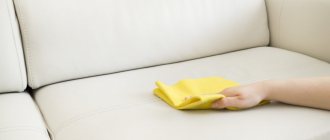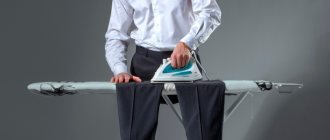Canvas is a fabric that serves as the basis for cross stitch and other counting techniques. The threads are woven evenly, which allows you to make crosses of the same size. Canvas is classified by material, size, and density.
Canvas count is the number of squares or threads per 1 cm of canvas. The larger it is, the smaller the stitches are, the more natural the work looks.
Differences between canvas and canvas
Canvas and canvas differ from each other primarily in convenience. If the first one itself is very soft and flexible, then the second one is quite dense to the touch. The canvas has small threads, so it is convenient to embroider with a half-cross, complex stitches, etc., but it is still not for everyone. The choice of canvas colors is much wider, but the canvas can boast of naturalness. The choice depends solely on the embroidery technique and the desired plot.
A palette for every taste
Hoop
To keep the fabric taut during embroidery, use a hoop . Embroidery done on a hoop has uniform thread tension and crosses of equal size. A round hoop consisting of two hoops, slightly different in diameter, with a plastic or metal screw. The simplest hoop is two rings inserted into each other, between which the fabric is clamped. Since the fabric must be well stretched, the difference in the diameters of the rings is very small. A ring of a smaller diameter is placed on a flat surface, the fabric is placed and leveled on it, and the second ring is put on top. During embroidery, the tension of the fabric may weaken, so it should be tightened. All the embroidery may not fit into the hoop, so you need to move it as needed. Currently, there are wooden, metal and plastic hoops. However, wooden ones are considered the best, because metal hoops are heavy, their smooth surface slips when fastening and dark circles remain on the fabric after hoopping, and plastic hoops are fragile. Hoops come in various shapes and sizes. There are hand and floor fingers with a bracket for changing the angle of embroidery.
Types of canvas and features of its use
In order to choose a material wisely, you must first know what it is and how each type is characterized.
- Aida. This is the most common type of canvas, made of 100% cotton. Its peculiarity is the weaving of 4*4 threads. It is always easy to embroider on it and produces beautiful, even crosses. Aida has several sizes. It is this characteristic that is usually paid attention to when purchasing. The most popular representatives on the market are Belarusian, Hungarian and German Zweigart fabric. Of course, the latter is one level superior to the others in quality - the embroidery on it is never deformed.
Aida
- Even weave canvas. Her squares are not as clearly visible as on Aida, but she produces amazing work, especially in cases where most of the parts remain unsewn (for example, napkins, tablecloths). The most popular uniform fabrics:
- Murano - composed of 48% viscose and 52% cotton. It is better to embroider on it using the technique of cross stitch, satin stitch, stitches, ideal for embroidering clothes. Manufactured by Zweigart;
- Lugana 25 - the same composition, weave is 25 threads per inch. When releasing this canvas, Zweigart imagined that it would be ideal for embroidering tablecloths, napkins, pillows and other elegant things. You can find it in sets from Janlynn;
- Linda 27 - 100% cotton, 27 threads per inch. The fabric is light, drapes well, making it very suitable for clothing and home textiles. It is a budget alternative to natural linen. Found in Heritage and LanArte sets.
You might be interested in what types of cellular tissue there are, features of the English cell
Even Weave Canvas
- Linen. Durable natural and noble fabric. Outwardly smooth, but very multifunctional in operation, but at the same time heavy. It is used for embroidery of clothes, paintings, and home textiles. Suitable for popular types of embroidery: cross stitch, stitching, hardanger. Flax also has its own classification:
- Cork 20 - 18 threads per inch. It has a modest palette of colors and is intended for embroidery through one thread;
- Dublin 25 - 25 threads per inch. Ideal for those who are just starting their acquaintance with flax;
- Cashel 28 - 28 threads per inch. The most popular type of flax, in appearance it resembles Aida 14;
- Belfast 32 - 32 threads per inch. Allows you to better detail the picture;
- Edinburgh 36 - 36 threads per inch. When working through 2 threads it is equal to Aida 18;
- Newcastle 40 - 40 threads per inch. Suitable for very painstaking work.
Canvas using linen
- Mixed flax. It is produced with an admixture of other fibers, which significantly reduces the cost of the fabric.
- Stramin. Used for tapestry embroidery (often used for pillows, found in Dimensions sets) and carpet stitching. It feels dense and hard, the structure is mesh.
Plastic canvas
- Plastic. This canvas is very dense and holds its shape well. Used for embroidering souvenirs, cards, Christmas tree decorations. Often products require figured cutting in which the edges on this fabric do not fray at all.
- Vinyl. Its properties are similar to plastic, but more flexible. Often used for embroidering bags, clutches, wallets, document covers, etc. The size most often corresponds to Aida 14.
Vinyl matter
- Overlay (removable) canvas. It is used on fabrics whose weave is not conducive to embroidery. It is applied to the product (most often these are dresses, T-shirts, bags and other things not intended for embroidery), the desired design is embroidered on it, and the threads are pulled out at the end of the work. The dimensions of this canvas are 8.5, 10, 14 or 18 cells per inch.
- Water soluble. The canvas is very close to the invoice with one exception - it dissolves well in water. It is enough to place the product in very warm (about 40 degrees) water for 10 minutes. The canvas will come off the fabric, but the design will remain.
Important! You should only embroider with threads that can withstand high temperatures and do not fade.
You might be interested in Description of the characteristics of bouclé fabric: use for coats
Water soluble
- Perforated. This canvas can be paper or wood. Suitable for embroidery of some interior decorations.
- Silk. No matter how strange it may sound, it is used as a canvas, but rarely. For 1 inch 24 - 112 threads. Silk is best suited for micro embroidery.
- Designer. This canvas allows you to embroider without sewing up the background. There may be patterns, stains or even some kind of design on it. Works on such a canvas look as beautiful as possible.
Designer
Compound
Embroidery fabrics are produced from different fibers:
- Natural (cotton, linen): hygroscopic, breathable material, easy to care for. It is convenient to tuck it into your fingers and machine. Disadvantages: wrinkles, may fray around the edges.
- Synthetics (nylon, polyester, nylon): wear-resistant, lightweight material. Keeps its shape well, is not saturated with odors, and repels dirt. Disadvantages: slippery, holes remain after the needle.
- Plastic: strong, durable material. Suitable for decorating hard surfaces, making bags, crafts, and household items.
- Paper: flexible but fragile stencil. Easily deteriorates, gets wet and breaks. But it is suitable for embroidery on small details and is cheap.
What does the canvas number mean? Russian and international classifications of Aida canvas
Since Aida is the most common type of canvas, its choice is given the most attention. Depending on what kind of work will be done on it, there are several classifications:
- Aida 7 (7 cells per inch/2.7 cells per centimeter). Canvas with very large checks, easy to work with, mainly suitable for those who are just learning embroidery or for children;
- Aida 11 (11 cells per inch/4.4 cells per centimeter). Suitable for embroidering simple patterns. You can embroider covers, tablecloths, etc. on this canvas.
Aida 11
- Aida 14 (14 cells per inch/5.5 cells per centimeter). The most popular canvas which. Used in most embroidery kits.
- Aida 16 (16 cells per inch/6.2 cells per centimeter). This canvas makes the embroidery more realistic and is not visible when working in 2 threads.
Aida 16
- Aida 18 (18 cells per inch/7.2 cells per centimeter). Small canvas, when working with which it is better to take a magnifying glass. The paintings look gorgeous on it, and the detailing is amazingly detailed.
- Aida 20 (20 cells per inch/7.9 cells per centimeter). On such a canvas, the embroidery process can be very painstaking and can only be done using tapestry stitch. Ideal for jewelry embroidery.
If in the international classification the number of cells per inch is used in the name, then in the Russian classification it is cells per centimeter, i.e. Aida 14 - Aida 5.5.
Needles
Needles are the most important embroidery tool. For cross stitch, blunt tapestry needles are used, because... a sharp needle can split the canvas or already embroidered crosses. Also, a distinctive feature of embroidery needles is their wide eye, so that you can easily insert six layers of thread. Needles vary in size; depending on the canvas number, the corresponding needle number is taken. Typically, the following table corresponds to the needle thickness of the canvas:
- Aida8 = 20 or 22 (needle no.)
- Aida11 = 22 or 24
- Aida14 = 22/24/26
- Aida18 = 24 or 26
- Aida20 = 24 or 26
- Hardanger22=28
There are special double-sided needles - two needles seem to be in end-to-end contact and have one common eye in the middle. This needle arrangement allows you to embroider with both hands at once: we hold one hand above the embroidery fixed in the frame, the other under it, thus, the hands do not make unnecessary movements.
Selecting fabric for embroidery based on manufacturer
The market offers a fairly large assortment of canvas manufacturers. The most popular today are Belarus, Hungary and Germany. In terms of properties, the first is very soft, but after a discount it is prone to deformation, the second is hard, which is not very convenient to use and does not look beautiful, the third is the option that you should give preference to without hesitation. The world's most popular German manufacturer is Zweigart. A huge variety of fabrics, amazing quality, wear resistance.
You might be interested in what is special about Vologda lace: the origin of the lace, simple patterns
Zweigart.
Embroidery is a very complex and painstaking work, so in order not to devalue your work, it is recommended to initially take good materials.
Characteristics
The properties of canvas and its purpose depend on the material from which it is made. Synthetic ones are convenient to use for products that should not be deformed, while natural ones are ideal for clothing, bedding, and children's things.
The main characteristics of the canvas that need to be taken into account:
- hypoallergenic;
- wear resistance;
- the ability to form puffs and pellets;
- breathability;
- shrinkage, stretching;
- degree of wetting/drying;
- color fastness (for colored products).
One of the most important characteristics of embroidery stencils is count. It is indicated by numbers that show the number of threads or squares in 1 inch or, in our case, 10 cm. The larger the number, the smaller and denser the squares in the canvas.
Choosing a canvas for bead embroidery with a ready-made print
It so happened historically that beads are embroidered according to patterns that are already applied to the fabric. The standard size of beads is marked No. 10. This size can only fit Aida 14.
Aida 14
Canva fabric is an indispensable companion for absolutely any needlewoman. The main thing is to learn to correctly assess your needs and choose the right fabric based on them. On the Internet you can find a large number of photos of canvas fabric in good quality, which will also fully help in choosing. To begin with, in order not to miss too much, you can buy small pieces of canvas and experiment.
Care
Canvas fabric is an auxiliary or main material, the safety of which determines the appearance of the future product and comfort during work.
General care rules:
- keep in a dry, ventilated place, protected from dirt and direct sunlight.
- It is better to store canvas in rolls and sheets in a horizontal position: this will protect them from bruises.
- Basic care is cleaning from dust.
- If necessary, hand washing is allowed at temperatures up to 40-60 °C.
- Dry flat on a soft surface.
Floss
Floss is a thread made specifically for embroidery or other types of needlework. World brands of floss manufacturers are DMC, Madeira and Anchor. In addition to them, quite high-quality Gamma/Gamma floss threads and threads from the Kirov spinning and thread mill (St. Petersburg), known since Soviet times, are still common in Russia. These cotton threads are specially designed for embroidery. Floss is sold in skeins of 8 (DMC, Gamma, Anchor), 10 (Madeira) and 20 meters (PNK im.Kirov). In some stores you can buy thread by the meter. Each floss manufacturer has its own set of colors; to select a color, you can use a color card (catalog with samples of threads of each color). If the embroidery pattern indicates colors for one brand of floss and you need to use threads from another manufacturer for embroidery, then use tables for converting colors of floss from one brand to another or comparing shades using color cards. Leading manufacturers (DMC, Gamma, Anchor, Madeira) have floss not only in plain colors, but also in melange (with a color transition) and with metallic colors. If you have bought threads whose quality you doubt, it is better to check whether they are fading before you start embroidering with them. To do this, you need to moisten them and forcefully pass them through a white cloth. If there are no traces left, it means the threads are not fading.
Other accessories
Scissors
of scissors are needed: large ones - for cutting fabric, small ones - for trimming the ends of the thread. If you don't have special embroidery scissors, regular nail scissors will do just fine.
Markers
A marker will also come in handy when embroidering . Markers are washable and disappearing. A disappearing marker is used to mark a place on the embroidery, and after a while the trace of such a marker disappears. Using a washable marker, draw the outline into cells to make it easier to compare the embroidery to the pattern; such markers are divided into markers for dark and light outline. Marker marks for light canvas should be washed off only with cold water, because... If exposed to heat, marks may remain forever. Marker marks for dark canvas can, on the contrary, be washed off with water or treated with a hot iron.
Fabric eraser
Often, to mark on fabric, we use a simple pencil, which will be quite problematic to remove from the fabric. fabric erasers will help with this problem . Unfortunately, not every pencil can be erased, so it’s best to try on a separate area first.
Magnetic and magnifying boards
While embroidering, we constantly look from the diagram to the work and back. It’s no wonder that you have to constantly look for the right place on the diagram, and if the diagram is printed with small symbols, then it’s just a disaster. A magnetic board and a board with magnifying rulers can help solve such difficulties . Magnetic Board is a board of magnetic material on which a circuit is placed and secured with magnetic strips. During the embroidery process, the slats are moved to the current place of embroidery, which allows you to avoid searching for the desired fragment on the pattern for a long time. The Line Magnifier device is almost the same, but it is also equipped with a magnifying rod, and this helps to see the necessary small symbols.
